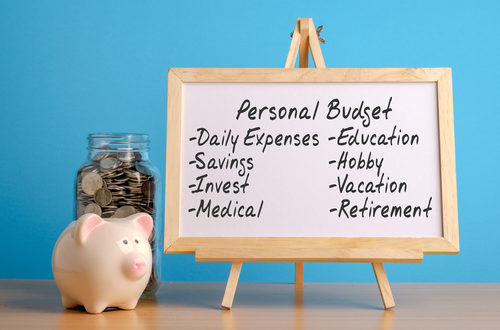Start building an effective budget by taking an inventory of your income. That means assessing both your net income or take-home pay (excluding taxes and employee benefits) and your expenses to create an accurate picture. Determine your needs and wants. Examples of needs might include rent or mortgage payment, food, utilities, debt payments, and savings, while wants may include entertainment, clothes, or gadgets.
1. Know Your Income
Your annual income is the sum total of all earnings potential in one year, including salary, bonuses, commissions, interest, and dividends. Your yearly earnings potential also serves to determine your tax bracket and potential deductions; lenders also use it as an indicator to establish loan eligibility or set credit card limits.
To calculate your annual income, start by determining your hourly wage as listed on your pay stub. If your hours vary significantly over time, use an average from previous weeks or months as an estimate. Next, account for deductions like taxes, health insurance premiums, and retirement savings contributions.
2. Know Your Expenses
Your long-term financial goals should play a pivotal role in shaping your budget, but to be able to start saving for them now, you must know where all your money is being spent now. Start by gathering all your account statements. These documents will detail all transactions for a particular timeframe.
Fixed expenses should be the first item on your checklist, including rent/mortgage payments, insurance payments, and subscription services. Next are expenses that vary month to month, such as groceries, gas, and entertainment costs. Finally, there are non-essential expenditures such as dinner out, shopping, and travel that are considered “wants.”
3. Know Your Goals
Setting goals helps individuals stay on the right path and remain budget conscious. Furthermore, setting realistic timelines will inform your financial plan. If you want to purchase a lake cabin, its timing could impact both your savings and expense plans. Perhaps over five years, save for a down payment?
Establishing specific goals for building an emergency fund, paying down debt, and increasing savings can help you meet them more easily. You might find ways to cut spending, such as dinners out or monthly subscriptions, in order to free up more funds to achieve your objectives.
4. Make a Plan
Once you know your expenses and goals, it is time to develop a plan. Start by determining your monthly net or take-home pay (pay stubs may help); freelance work and passive income sources like royalties or child support payments may all count towards this figure.
Next, gather an estimate of your expected expenses – both fixed expenses like mortgage or rent payments, utility bills, and insurance premiums, as well as variable spending like food, travel, and entertainment expenses. Divide these into categories and set aside money for each one as though paying in cash.
5. Track Your Spending
Tracking your spending is an essential element of a budget. By tracking what you spend each month, tracking can help identify areas for savings that will lead to reaching your goals, whether that means getting rid of debt, saving for vacation, or something else entirely.
Start by calculating your net income or take-home pay. This is the remaining amount after subtracting taxes and applying employee benefits. Make a list of your fixed expenses, such as rent or mortgage payments, utility payments, and insurance policies. Also create a line item for variable expenses like groceries and dining out that you estimate monthly and set aside an amount in savings or other goals.
6. Manage Your Cash
Money management means understanding where it goes – a critical aspect of reaching financial goals. Use an app like YNAB, Monarch, or Rocket Money to track and organize your spending. As part of your budgeting strategy, it’s essential that you consider both fixed and variable expenses, including mortgage/rent payments, insurance costs, and food. Also take into account “one-off” purchases like new gaming consoles.
An envelope budget can be an effective way of managing variable spending. Simply create an envelope for each spending category, and only spend from it if enough funds exist in its corresponding envelope.
7. Set Goals
Once you understand how you’re earning and spending your income, the next step should be setting some goals. The first step should be separating needs from wants; these could include necessities like housing, food, and transportation, while wants could include more personalized items like dinners out, gifts, or travel.
Set both short- and long-term financial goals. Make sure these are specific, measurable, attainable, and relevant to your financial priorities. Once set, set aside money each month toward this goal in addition to expenses; this will help avoid unneeded spending.
8. Pay Yourself
Paying yourself first is an effective budget strategy to promote sound savings habits by setting aside some of your income as savings or investment accounts, whether that’s through workplace retirement plans, savings apps, or traditional bank checks deposited each time you get paid.
If you opt for this strategy, make sure that you track your expenses using an Excel sheet or budgeting app so you know exactly how much is spent and can set aside savings before any of it goes elsewhere. This will enable you to determine how much needs to go towards saving for retirement.
9. Make a Plan for the Future
Once you’ve created a financial plan, stick to it ; making any necessary modifications may help ensure you reach your goals more quickly. Attain your short- and midterm financial goals (buying headphones, living within your means) before setting aside funds for future purchases such as cars or houses by creating an action plan to save more. Cut back on spending, such as going out to lunch less or forgoing Starbucks beverages for six months, in order to afford the headphones you desire.
Start out using tools such as a budget spreadsheet, zero-based budget, or the envelope system to establish your personal financial plan. Keep track of income and expenses on an ongoing basis and adjust as necessary.

